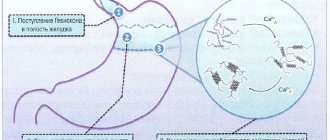Directions for use and dosage
To prevent dehydration, the use of Oralit should be started as soon as diarrhea begins. Usually the drug needs to be used for no more than 3-4 days, treatment is stopped when the diarrhea ends.
If nausea or vomiting occurs, it is advisable to take the solution chilled in small portions (for example, teaspoons).
Fluid replacement
To replenish fluid, Oralit is taken during the first 6-10 hours in an amount that is twice the weight loss caused by diarrhea.
Pharmacological properties of the drug Uralit-u
Pharmacodynamics. Salts of strong bases combined with weak acids alkalize (neutralize) the pH of the urine, and the acid component is metabolized. The citrate ion from alkaline citrates undergoes oxidative metabolic breakdown to carbon dioxide or bicarbonate. The remainder of the base, which is formed from the remaining alkali ions, is excreted by the kidneys and increases the pH of the urine. Neutralization or alkalinization of urine can be achieved by oral administration of alkaline citrates; the reaction to the drug is dose-dependent. 1 g of hexacalium-hexasodium-trihydropentacytrate complex (8.8 mmol of alkali) increases urine pH by 0.2–0.3 units. As a result, the degree of dissociation and solubility of uric acid increase. Dissolution of uric acid stones was confirmed radiographically. The concentration of bicarbonate (a negatively charged base residue) in the blood plasma regulates the excretion of citrate. The negatively charged base residue induces (stimulates) alkalosis by changing intracellular pH. Alkalosis inhibits tubular metabolism of citrate in the kidneys, which leads to decreased absorption of citrate and increased excretion. In addition, alkalosis affects excessive calcium excretion and reduces urinary calcium excretion. Alkalinization of urine increases the excretion of citrate and reduces the excretion of calcium, which leads to a decrease in the activity of calcium oxalate, since citrate forms stable complexes with calcium in a weak alkaline environment. Therefore, citrate ion is the most effective physiological inhibitor of crystallization of calcium oxalate, calcium phosphate and aggregation of these crystals. Based on observations, we can talk about a therapeutic effect for:
- Cystinuria and the formation of cystine stones: alkalinization of urine increases the solubility of cystine. The urine pH should reach 7.5–8.5;
- therapy with cytostatics: a shift in the urine reaction to the alkaline side in order to increase the elimination of uric acid is indicated during treatment with cytostatics (prevention of the formation of uric acid stones). In addition, the protective effect of the alkaline reaction of urine has been confirmed due to a decrease in the aggressiveness of cytostatic metabolites (for example, oxazaphosphorus cytostatics) and an increase in the solubility of cytostatics and their metabolites (methotrexate), respectively. Urine pH should be maintained at 7;
- In skin porphyria tarda there is a deficiency of uroporphyrinogen decarboxylase, which converts uroporphyrinogen into coproporphyrinogen. The purpose of metabolic alkalization is to prevent re-diffusion of coproporphyrin through the renal tubules in order to increase the clearance of coproporphyrin. Due to increased excretion of coproporphyrinogen, the synthesis of coproporphyrinogen from uroporphyrinogen increases, which is accompanied by a decrease in the circulation of uroporphyrin. Urine pH should be 7.2–7.5.
Pharmacokinetics. Citrate is almost completely subject to metabolic breakdown. Only 1.5–2% of the initial dose is detected unchanged in the urine. Taking 10 g of hexacalium hexasodium trihydropentacytrate complex produces approximately 36 mmol of citrate, which is equivalent to less than 2% of the body's daily turnover of citrate involved in energy metabolism. After taking hexacalium-hexasodium-trihydropentacitrate complex (for 1 day), an equivalent amount of sodium and potassium is excreted by the kidneys for 24-48 hours. With long-term use, the daily excretion of sodium and potassium is equal to the daily intake. Significant changes in the gas composition of the blood and electrolytes of the blood plasma are not noted. This indicates that, thanks to renal regulation, the body's COR remains stable and, with normal kidney function, the possibility of sodium or potassium accumulation is excluded.
Children
For children, Oralit is indicated for dehydration, due to vomiting, diarrhea caused by rotavirus infection, poisoning with toxins or any other pathogen, burns, intestinal obstruction. A small child has a faster metabolism than an adult, the frequency of stools is higher and, therefore, the loss of fluid from the body is more noticeable. Without water-salt solutions to prevent dehydration, the baby is in serious danger.
In case of I – II degree of dehydration, if the child drinks on his own, oral rehydration is performed with a glucose-saline solution. Oralit should be given in small portions of 10–15 ml at intervals of 15–20 minutes. The maximum daily dose is 180 – 200 ml/kg.
Newborns and premature babies need to dilute Oralit with distilled water 2 times, since the solution contains a lot of sodium.
For children under 3 years of age, a rational solution would be to combine glucose-saline solutions and salt-free solutions (water, tea, rosehip infusion, rice infusion). The ratio of solutions is determined based on the volume of fluid loss.
Instructions for use of URALIT-U®
Before starting therapy, it is necessary to conduct examinations aimed at identifying all cases of concomitant diseases that contribute to the formation of kidney stones in order to exclude them. This also applies to cases amenable to specific therapy (parathyroid adenoma, malignant tumors generating the formation of uric acid stones, etc.).
Before the first dose, it is necessary to determine the concentration of electrolytes in the serum and check renal function. In addition, if renal tubular acidosis (RTA) is suspected, the acid-base status should be checked.
Uralit-U contains sunset yellow dye (E 110), which in rare cases can cause allergic reactions, including bronchial asthma in sensitized individuals. Allergic reactions are more common in people with hypersensitivity to acetylsalicylic acid.
Use in patients with impaired liver function
Caution should be exercised when using the drug Uralit-U in patients with severe liver dysfunction.
Use in patients with impaired renal function
Uralit-U is a well-tolerated and safe drug, but all three compounds are primarily excreted through the kidneys. The drug Uralit-U in granules should not be used in cases of acute or chronic renal failure, metabolic alkalosis, hyperkalemia and chronic urethral infections, as well as in conditions of a diet low in sodium.
Serum electrolyte analysis and monitoring of renal function are recommended in patients with impaired renal function. If renal tubular acidosis is suspected, regular testing of acid-base status is necessary.
Use of the drug in children
Use in children under 12 years of age is not recommended as there is insufficient clinical experience in this age group.
Application in geriatric practice
There is limited data on the use of Uralit-U in elderly patients. When prescribing the drug to elderly patients, caution should be exercised due to possible age-related changes in renal function.
Careful individual patient assessment is required before initiating treatment in this subgroup of patients.
In addition, during long-term use in elderly patients, periodic monitoring of blood electrolytes, particularly potassium and renal function, is generally recommended to detect age-related changes.
The recommended maximum daily dose of Uralit-U is 11.25 g of granules (4.5 scoops), which contains 1.86 g of potassium and 1.09 g of sodium, i.e., 47.5 mmol of potassium and 47.5 mmol of sodium.
This should be taken into account, especially in the elderly and in patients who are simultaneously taking potassium-sparing diuretics, aldosterone antagonists, ACE inhibitors, angiotensin receptor antagonists, non-steroidal anti-inflammatory drugs and peripheral analgesics.
Patients should exercise caution regarding potassium dosage intake due to the risk of hyperkalemia or the hypertensive effects of sodium.
Impact on the ability to drive vehicles and operate machinery
Absent.
Overdose of the drug Uralit-u, symptoms and treatment
With normal renal function, no undesirable effect on normal metabolic parameters is expected, even after administration in doses much higher than recommended (due to excretion of the base by the kidneys, a natural regulatory mechanism is triggered that maintains KOR in the body). Elevation of urine pH above the recommended range should not continue for more than a few days, since high pH levels increase the risk of phosphate crystallization and a state of metabolic alkalosis may occur, which is in any case undesirable. Overdose is stopped by reducing the dose; If necessary, metabolic alkalosis is corrected.
Interactions of the drug Uralit-u
Any increase in extracellular potassium concentration will reduce the effect of cardiac glycosides, whereas any decrease will potentiate the arrhythmic effect of cardiac glycosides. Aldosterone antagonists, potassium-sparing diuretics, ACE inhibitors, NSAIDs and peripheral analgesics reduce renal excretion of potassium. It should be remembered that 1 g of Uralit-U contains 0.172 g or 4.4 mmol of potassium. When following a low-sodium diet, you must remember that 1 g of Uralit-U contains 0.1 g or 4.4 mmol of sodium, which is equivalent to 0.26 g of sodium chloride. Preparations containing citrates and used simultaneously with drugs containing aluminum may increase the absorption of aluminum, so the interval between taking each of them should be at least 2 hours.
Use of the drug Uralit-u
Uralit-U is taken orally. Before use, the granules are dissolved in a glass of water. The dose of the drug is selected individually based on determination of urine pH values. 1. To dissolve and prevent recurrence of uric acid stones, prescribe 4 scoops (10 g of granules, equivalent to 88 mmol of alkali) per day, divided into 3 doses: 1 scoop in the morning, 1 scoop at noon and 2 scoops - In the evening. The drug is taken after meals. The pH of fresh urine should be 6.2–6.8. If the pH value is below the recommended range, the daily dose is increased by 0.5 scoop (11 mmol of alkali) in the evening. If the pH value is above the recommended range, the daily dose is reduced by 0.5 scoop (11 mmol of alkali) in the evening. The dose is considered correctly selected if the pH of fresh urine before taking Uralit-U is within the recommended range. When taken to prevent recurrence of uric acid stones, regular testing of urine pH is recommended. 2. To prevent the recurrence of calcium-containing kidney stones, the daily dose should be 2-3 scoops (5-7.5 g granules, equivalent to 44-66 mmol alkali) and taken as a single dose in the evening. If the pH value is very low, take 3–4.5 scoops (7.5–11.25 g granules, equivalent to 66–99 mmol alkali) in 2–3 divided doses after meals. The urine pH value should be around 7.0 (range 6.2–7.4). It is necessary to regularly check the citrate level and/or urine pH value and determine the dose accordingly (see above). Measuring urine pH. Before taking each dose, take the test strip contained in the package, hold it with a clip (also included), and dip it into fresh urine. The color of the wet strip is then compared to the color chart and the corresponding urine pH value is determined. The urine pH value and the number of measuring spoons with granules that need to be used are recorded in the control calendar. At each visit to the doctor, the patient should take a control calendar with him.


